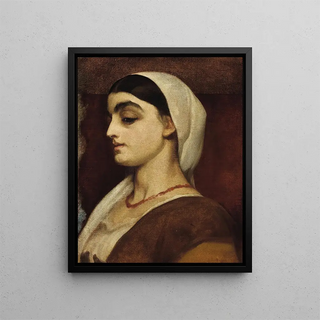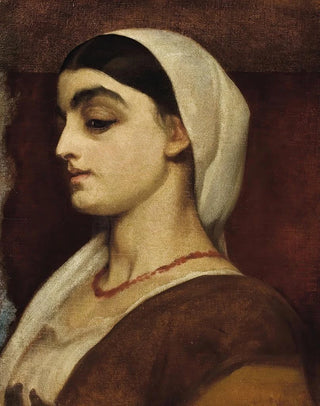Portrait Painting of Stella - Frederic Leighton | Art print


View from behind

Frame (optional)
Portrait of Stella - Frederic Leighton – Captivating Introduction
The "Portrait of Stella" by Frederic Leighton is a work that transcends the simple frame of painting to be recognized in art history as a vibrant testament to Victorian aesthetics. Created at the end of the 19th century, this portrait embodies not only the physical beauty of its model, Stella, but also a psychological depth that invites the viewer to contemplate the soul of the young woman. The soft light bathing Stella's face and the delicate drapery of her dress create an intimate, almost dreamlike atmosphere that captivates the observer. This artwork, through its elegance and finesse, continues to evoke the emotion and sensitivity characteristic of Leighton's art.
Style and uniqueness of the work
Frederic Leighton's style is often associated with the Pre-Raphaelite movement, but his unique approach gives him an undeniable singularity. In "Portrait of Stella," Leighton combines refined pictorial technique with a harmonious composition. The colors, subtly nuanced, demonstrate an exceptional mastery of light and shadow. Stella's face, delicately modeled, appears alive, while the details of her hairstyle and clothing are treated with meticulousness that reflects the artist's attention to detail. The model's pose, both natural and posed, creates a perfect balance between intimacy and dignity, making this portrait both accessible and mysterious. Every brushstroke seems to tell a story, and the entire work invites prolonged contemplation.
The artist and his influence
Frederic Leighton, born in 1830, is one of the major figures of the British artistic movement of the late 19th century. His career, marked by stays in Europe, notably in Italy, profoundly influenced his style and artistic vision. Leighton knew how to blend classical influences with modern sensibility, creating works that speak equally to contemporaries and future generations. As president of the Royal Academy, he also played a key role in supporting and promoting British art. His approach to portraiture, in particular, paved the way for many artists, who sought to capture

Matte finish

View from behind

Frame (optional)
Portrait of Stella - Frederic Leighton – Captivating Introduction
The "Portrait of Stella" by Frederic Leighton is a work that transcends the simple frame of painting to be recognized in art history as a vibrant testament to Victorian aesthetics. Created at the end of the 19th century, this portrait embodies not only the physical beauty of its model, Stella, but also a psychological depth that invites the viewer to contemplate the soul of the young woman. The soft light bathing Stella's face and the delicate drapery of her dress create an intimate, almost dreamlike atmosphere that captivates the observer. This artwork, through its elegance and finesse, continues to evoke the emotion and sensitivity characteristic of Leighton's art.
Style and uniqueness of the work
Frederic Leighton's style is often associated with the Pre-Raphaelite movement, but his unique approach gives him an undeniable singularity. In "Portrait of Stella," Leighton combines refined pictorial technique with a harmonious composition. The colors, subtly nuanced, demonstrate an exceptional mastery of light and shadow. Stella's face, delicately modeled, appears alive, while the details of her hairstyle and clothing are treated with meticulousness that reflects the artist's attention to detail. The model's pose, both natural and posed, creates a perfect balance between intimacy and dignity, making this portrait both accessible and mysterious. Every brushstroke seems to tell a story, and the entire work invites prolonged contemplation.
The artist and his influence
Frederic Leighton, born in 1830, is one of the major figures of the British artistic movement of the late 19th century. His career, marked by stays in Europe, notably in Italy, profoundly influenced his style and artistic vision. Leighton knew how to blend classical influences with modern sensibility, creating works that speak equally to contemporaries and future generations. As president of the Royal Academy, he also played a key role in supporting and promoting British art. His approach to portraiture, in particular, paved the way for many artists, who sought to capture
12,34 €






